Quality of working life: association with work and health factors
Vztah kvality pracovního života s determinanty práce a zdraví
Martin Štěpánek1
1Occupational Safety Research Institute, Czech Republic, stepanek@vubp.cz
Abstract
Quality of working life in the Czech Republic has been regularly assessed at the national level using the Subjective Quality of Working Life index (SQWLi), yet little is known about the relationships between the individual domains, as well as their relationships with other aspects of workers’ lives. This article shows that there is a strong correlation among the domains in terms of importance and evaluation, separately, but the cross-correlation between importance and evaluation is low. Higher work flexibility, better overall job characteristics, and better physical and mental health are all associated with higher working life evaluation.
Keywords: SQWLi, quality of working life, Czech Republic
Abstrakt
Kvalita pracovního života je v České republice dlouhodobě měřena na celonárodní úrovni za pomoci indexu Subjective Quality of Working Life (SQWLi), nicméně vztahy mezi jednotlivými doménami indexu, stejně jako vztahy k dalším faktorům pracujících, zatím v literatuře nebyly do detailu popsány. V tomto článku popisujeme silnou korelaci mezi jednotlivými doménami z hlediska jejich důležitosti a hodnocení (samostatně), zatímco vztah mezi důležitostí a hodnocením je minimální. Ukazujeme také, že vyšší míra pracovní flexibility, všeobecně lepší charakteristika práce a lepší psychické a fyzické zdraví jsou pozitivně korelovány se hodnocením kvality pracovního života.
Klíčová slova: SQWLi, kvalita pracovního života, Česká republika
Přijat k publikování / Received for publication 10. 11. 2022
Introduction
Trends in quality of work life in the Czech Republic have been regularly tracked at the population level using the Subjective Quality of Working Life index (SQWLi; see Vinopal, 2009, Vinopal, 2011, Vinopal, 2012, Vinopal and Pospíšilová, 2021) by the Occupational Safety Research Institute and Institute of Sociology at the Czech Academy of Sciences since 2011. The results, along with various in-depth insights, have been extensively published in the Journal of Safety Research and Applications (JOSRA) (see e.g., Čadová, 2018, Červenka, 2021, Dvořáková, 2018). However, the studies typically analyse associations of the overall quality of working life in context of a specific issue (e.g., work arrangements, see Štěpánek, 2022); look at the changes in quality of working life over time (see Vinopal, 2018); or analyse discrepancies in scores of the individual domains (see Vinopal, 2015). Little has been written on the inner relationships among the individual SQWLi domains thus far, and particularly their association with other aspects of workers’ lives.
This article provides deeper insights into the relationships, considering specifically work flexibility, job characteristics, and physical and mental health.
Data
We utilise data from a population-representative survey conducted in November 2020 by the Institute for Sociology of the Czech Academy of Sciences. The survey collected a total of 2,026 responses from the 6,095 initial survey requests using a computer-assisted web interviewing (CAWI) method. The collected data are representative of employees in the Czech Republic, 18-65 years of age, in terms of gender, age, education, region of residence and type of economic activity (employee/entrepreneur).
Quality of working life is assessed using the SQWL index (Vinopal, 2009). We present both importance and evaluation of the overall quality of working life, as well as with each of its six domains. All variables are presented at a 0-100 scale, with higher values representing greater importance and higher evaluation. In addition to the questions assessing quality of working life across the six domains, information is obtained about respondents’ age, gender, region of residence and more. Following are key descriptive statistics of the dataset.
Other variables used in the analysis include job characteristics, work flexibility, and physical and mental health. Work flexibility is captured using a single latent variable (factor) consisting of ability to work flexible hours, to work from home, to take breaks at will, to take time off at will, and to make up time off on another occasion (omega reliability coefficient ω=0,82). Work characteristics are captured through another factor variable consisting of work monotony, career progress opportunities, boringness, control over one’s work tasks, help from others, and feeling at work like at home (ω=0,71). Refer to Stepanek (2022) for detailed description of the underlying questions and modelling of the latent variables.
Physical health is assessed using a single question “How is your physical health in general?” (1 = Very poor to 5 = Very good). Mental health is assessed using a composite variable consisting of eight questions from the European Quality of Life Survey (EQLS, 2016; questions Q51 and Q52). For all questions, higher values represent better outcomes and so the higher the composite score, the better is one’s mental health.
| Variable | Category | Freq./ Mean | SD | Min | Max | Missing obs. |
|---|---|---|---|---|---|---|
| Age | Years | 43.0 | 11.3 | 18 | 65 | 0 |
| Income | CZK/month | 25,261 | 13,936 | 0 | 250,000 | 536 |
| Gender | Male | 56.7% | 0 | |||
| Education | None or primary | 2.2% | 0 | |||
| Secondary (GCSE equivalent) | 33.1% | |||||
| Secondary (A levels equivalent) | 34.9% | |||||
| Post-secondary or undergraduate | 9.9% | |||||
| Graduate or postgraduate | 19.8% | |||||
| Job position | Skilled agricultural, forestry and fishery workers | 7.4% | 80 | |||
| Plant and machine operators, and assemblers | 8.2% | |||||
| Craft and related trades workers | 12.1% | |||||
| Service and sales workers | 17.8% | |||||
| Clerical support workers | 19.7% | |||||
| Technicians and associate professionals | 15.9% | |||||
| Professionals | 16.0% | |||||
| Managers | 2.9% | |||||
| Organisation type | Private enterprise | 70.2% | 359 | |||
| State enterprise | 5.2% | |||||
| Public institution or NGO (school, hospital) | 10.7% | |||||
| Public office | 13.9% | |||||
| Organisation size (number of employees) | 1-9 | 23.2% | 79 | |||
| 10-19 | 10.8% | |||||
| 20-49 | 13.2% | |||||
| 50-249 | 22.5% | |||||
| 250+ | 30.2% |
Table 1: Descriptive statistics of the collected dataset
Associations among SQWLi domains
As a first step we explore the associations among the SQWLi domains, as depicted in Table 1. There are clear links between the individual domains in terms of importance and evaluation, respectively, but the cross-correlation between importance and evaluation is limited. That is, evaluation of working life quality is largely independent of how important the individual domains are to a worker. The only exception is the link between importance and evaluation of self-realisation (r=0,41), which is substantially higher than the other correlations for the same domains, as well as for cross-domain links.
| 1 | 2 | 3 | 4 | 5 | 6 | 7 | 8 | 9 | 10 | 11 | 12 | |
|---|---|---|---|---|---|---|---|---|---|---|---|---|
| 1 - Importance - Remuneration | - | |||||||||||
| 2 - Importance - Relationships | 0.41 | - | ||||||||||
| 3 - Importance - Time | 0.35 | 0.34 | - | |||||||||
| 4 - Importance - Self-realisation | 0.30 | 0.38 | 0.26 | - | ||||||||
| 5 - Importance - Security | 0.54 | 0.40 | 0.36 | 0.35 | - | |||||||
| 6 - Importance - Conditions | 0.46 | 0.51 | 0.37 | 0.43 | 0.46 | - | ||||||
| 7 - Evaluation - Remuneration | 0.07 | 0.14 | 0.01 | 0.17 | 0.09 | 0.09 | - | |||||
| 8 - Evaluation - Relationships | 0.09 | 0.23 | 0.06 | 0.21 | 0.10 | 0.15 | 0.55 | - | ||||
| 9 - Evaluation - Time | 0.09 | 0.16 | 0.12 | 0.16 | 0.13 | 0.16 | 0.44 | 0.43 | - | |||
| 10 - Evaluation - Self-realisation | 0.09 | 0.20 | 0.01 | 0.41 | 0.16 | 0.20 | 0.53 | 0.56 | 0.41 | - | ||
| 11 - Evaluation - Security | 0.16 | 0.18 | 0.10 | 0.25 | 0.21 | 0.18 | 0.55 | 0.45 | 0.37 | 0.51 | - | |
| 12 - Evaluation - Conditions | 0.12 | 0.19 | 0.09 | 0.23 | 0.15 | 0.24 | 0.53 | 0.55 | 0.39 | 0.49 | 0.43 | - |
Table 1: Correlation matrix for the six SQWLi domains
Within the importance and evaluation domains, the correlation coefficients are generally higher for evaluation. That is, evaluating an aspect of working life higher increases probability of evaluating other aspects higher as well, more so than for measures of importance.
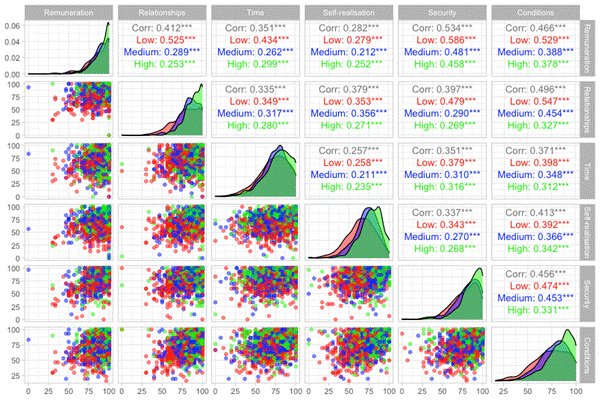
Figure 1: Associations among the SQWLi domains (importance), conditional on overall evaluation of working life quality.
Note: Colour-coding represents low, medium, and high quality of working life (see text for details). Distributions of variables listed in rows/columns on the diagonal; correlation coefficients for variables specified in the given column and row in the upper-right section; individual data points in scatter plots in the bottom-left section.
Figure 1 then offers a similar view – showing the associations between domain importance – but depicts the detailed distributions (see the diagonal) and also shows differences in the correlation coefficients by the overall evaluation score (with 70 and 85 on the 0-100 score serving as thresholds). As per the above, importance of remuneration is rather independent of evaluation, resulting in nearly overlapping distributions. Self-realisation, on the other hand, shows the greatest differences in the overlap, with workers who evaluate their overall quality of working life lower (red distribution) showing substantially lower importance of self-realisation.
The overall evaluation levels also affect the correlation coefficients: low evaluation is typically associated with higher domain importance correlation. That is, workers who evaluate their quality of working life lower are typically more consistent in their importance scoring.
Associations with other aspects of work
Next, we consider links between the individual SQWLi domains and other aspects of work, specifically work characteristics work flexibility (see Figures 1 and 2). Both variables are split into equal proportions to represent those with low (bottom 33%), medium (middle 33%) and high (top 33%) work flexibility and poor/fair/good job characteristics.
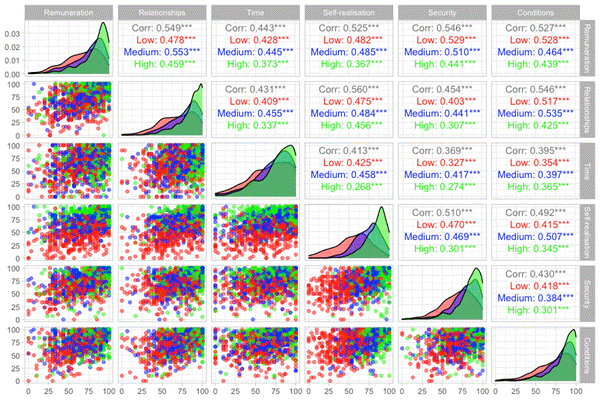
Figure 2: Associations among the SQWLi domains (evaluation), conditional on job characteristics
Note: Colour-coding represents poor, fair, and good job characteristics (low, medium, and high factor value, respectively). Distributions of variables listed in rows/columns on the diagonal; correlation coefficients for variables specified in the given column and row in the upper-right section; individual data points in scatter plots in the bottom-left section.
Figure 2 shows the associations between SQWLi domain evaluation and job characteristics. Red distributions are again shifted to the left, meaning that workers in jobs with worse characteristics typically evaluate their quality of their working life lower. This is particularly true for self-realisation, work relationships, and job security, but it is evident for all domains. Job characteristics play less important role in altering correlation between evaluation of the individual domains, although those with better job characteristics are again typically less consistent in their ratings.
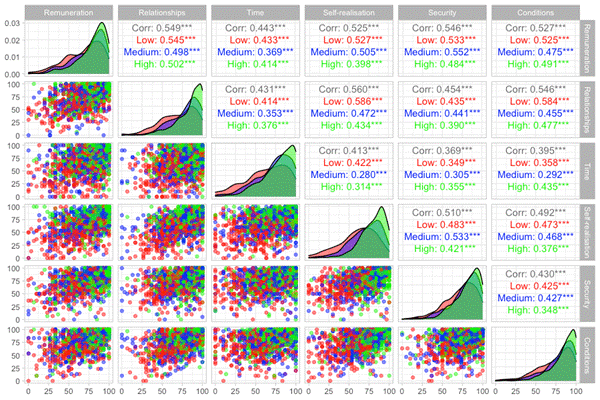
Figure 3: Associations among the SQWLi domains (evaluation), conditional on work flexibility
Note: Colour-coding represents low, medium, and high levels of the work flexibility. Distributions of variables listed in rows/columns on the diagonal; correlation coefficients for variables specified in the given column and row in the upper-right section; individual data points in scatter plots in the bottom-left section.
Work flexibility offers a very similar view (see Figure 3), partially due to the correlation between work flexibility and better working conditions. Workers with lower flexibility again show overall lower evaluation of their working life quality.
Associations with health
Finally, we look at associations of the overall quality of working life importance and evaluation with broader physical and mental health status (see Figures 4 and 5). For physical health, scores 1-2 were coded as poor (red), score 3 as blue (fair) and scores 4-5 as good (green). The mental health score was again split into three equal portions, with higher values representing better mental health.
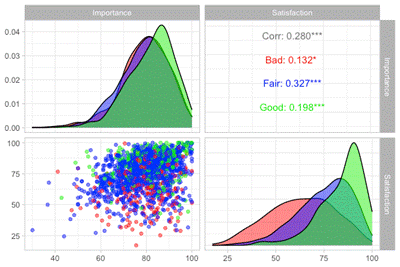
Figure 4: Associations between the SQWLi scores, conditional on mental health
Note: Colour-coding represents mental health status. Distributions of variables listed in rows/columns on the diagonal; correlation coefficients for variables specified in the given column and row in the upper-right section; individual data points in scatter plots in the bottom-left section.
Both health dimensions are positively associated with the overall SQWLi evaluation scores, with particularly mental wellbeing having a significant relationship with the evaluation scores, shifting the distributions to the right. That is, workers with better health typically report better quality of working life. The existing literature suggests that this is a bi-directional relationship, i.e., that health can determine quality of job opportunities, and quality of working life can affect particularly mental health (see e.g., Butterworth et al., 2011, Peckham et al., 2019).
Health dimensions are also to a small extent positively associated with importance of quality of working life domains. This is particularly true for poor physical health, which significantly increases probability of having low importance score.
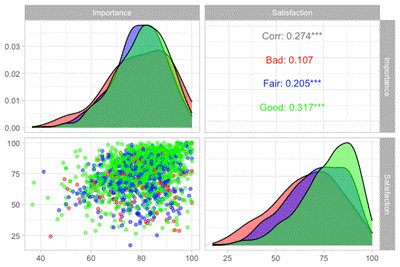
Figure 5: Associations between the SQWLi scores, conditional on physical health
Note: Colour-coding represents physical health status. Distributions of variables listed in rows/columns on the diagonal; correlation coefficients for variables specified in the given column and row in the upper-right section; individual data points in scatter plots in the bottom-left section.
Conclusion
This article sheds additional light on the inner correlations of the individual domains of the Subjective Quality of Working Life index, as well as the associations of the overall index scores with one’s physical and mental health.
It shows that there is a strong correlation among the domains in terms of importance and evaluation, separately, but the cross-correlation between importance and evaluation is low. Higher work flexibility, better overall job characteristics, and better physical and mental health are all associated with higher working life quality evaluation.
Dedication

©2022
References
Butterworth, P. …[et al.]. 2011. The psychosocial quality of work determines whether employment has benefits for mental health: results from a longitudinal national household panel survey. Occupational and environmental medicine. 2011, vol. 68, no. 11, s. 806-812.
Čadová, N. 2018. Subjektivní vnímání životní spokojenosti u ekonomicky aktivní populace České republiky. Časopis výzkumu a aplikací v profesionální bezpečnosti [online]. 2018, roč. 11, č. Kvalita pracovního života 2018. Dostupný z: https://www.bozpinfo.cz/josra/subjektivni-vnimani-zivotni-spokojenosti-u-ekonomicky-aktivni-populace-ceske-republiky. ISSN 1803-3687.
Červenka, J. 2018. Prestiž vlastního povolání v hlavním zaměstnání v ČR. Časopis výzkumu a aplikací v profesionální bezpečnosti [online]. 2018, roč. 11, č. Kvalita pracovního života 2018. Dostupný z: https://www.bozpinfo.cz/josra/prestiz-vlastniho-povolani-v-hlavnim-zamestnani-v-cr. ISSN 1803-3687.
Dvořáková, Z. 2018. Nová role personálního managementu ke zlepšení kvality pracovního života v ČR. Časopis výzkumu a aplikací v profesionální bezpečnosti [online]. 2018, roč. 11, č. Kvalita pracovního života 2018. Dostupný z: https://www.bozpinfo.cz/josra/nova-role-personalniho-managementu-ke-zlepseni-kvality-pracovniho-zivota-v-cr. ISSN 1803-3687.
European Quality of Life Survey (EQLS). 2016. Dublin: Eurofound, 2016.
Peckham, T. …[et al.]. 2019. Evaluating employment quality as a determinant of health in a changing labor market. RSF: The Russell Sage Foundation Journal of the Social Sciences. 2019, vol. 5, no. 4, s. 258-281.
Štěpánek, M. 2022. Should work contracts change to improve quality of work life?: a structural modelling approach. Časopis výzkumu a aplikací v profesionální bezpečnosti [online]. 2022, roč. 15, č. 1-2. Dostupný z: https://www.bozpinfo.cz/josra/should-work-contracts-change-improve-quality-work-life-structural-modelling-approach. ISSN 1803-3687.
Vinopal, J. 2009. The Instrument for Empirical Surveying of Subjectively Perceived Quality of Life: paper presented at the conference Working conditions and Health and Safety surveys in Europe: stocktaking, challenges and perspectives. Brussels: European Trade-Union Institute, 2009 March 18-19.
Vinopal, J. 2011. Indikátor subjektivní kvality pracovního života. Sociologický časopis/Czech Sociological Review. 2011, roč. 47, č. 5, s. 937-965.
Vinopal, J. 2012. The discussion of subjective quality of working life indicators. Sociológia-Slovak Sociological Review. 2012, vol. 44, no. 3, s. 385-401.
Vinopal, J. 2015. Mají Češi dobrou práci? I. Časopis výzkumu a aplikací v profesionální bezpečnosti [online], 2015, roč. 8, speciální č. Kvalita pracovního života. Dostupný z: http://www.bozpinfo.cz/josra/josra-kvalita-zivota/maji-cesi-dobrou-praci.html. ISSN 1803-3687.
Vinopal, J. 2018. Vývoj subjektivní kvality pracovního života v ČR. Časopis výzkumu a aplikací v profesionální bezpečnosti [online]. 2018, roč. 11, č. Kvalita pracovního života 2018. Dostupný z: https://www.bozpinfo.cz/josra/vyvoj-subjektivni-kvality-pracovniho-zivota-v-cr. ISSN 1803-3687.
Vinopal, J.; Pospíšilová, K. 2021. Measurement invariance of the SQWLi instrument over time. Sociologický časopis/Czech Sociological Review. 2021, roč. 57, č. 3, s. 343-375.
Vzorová citace
ŠTĚPÁNEK, Martin. Quality of working life: association with work and health factors. Časopis výzkumu a aplikací v profesionální bezpečnosti [online]. 2022, roč. 15, č. 3-4. Dostupný z: https://www.bozpinfo.cz/josra/quality-working-life-association-work-and-health-factors. ISSN 1803-3687.
Užitečné odkazy
Provozovatel portálu
Jeruzalémská 1283/9
110 00 Praha 1


